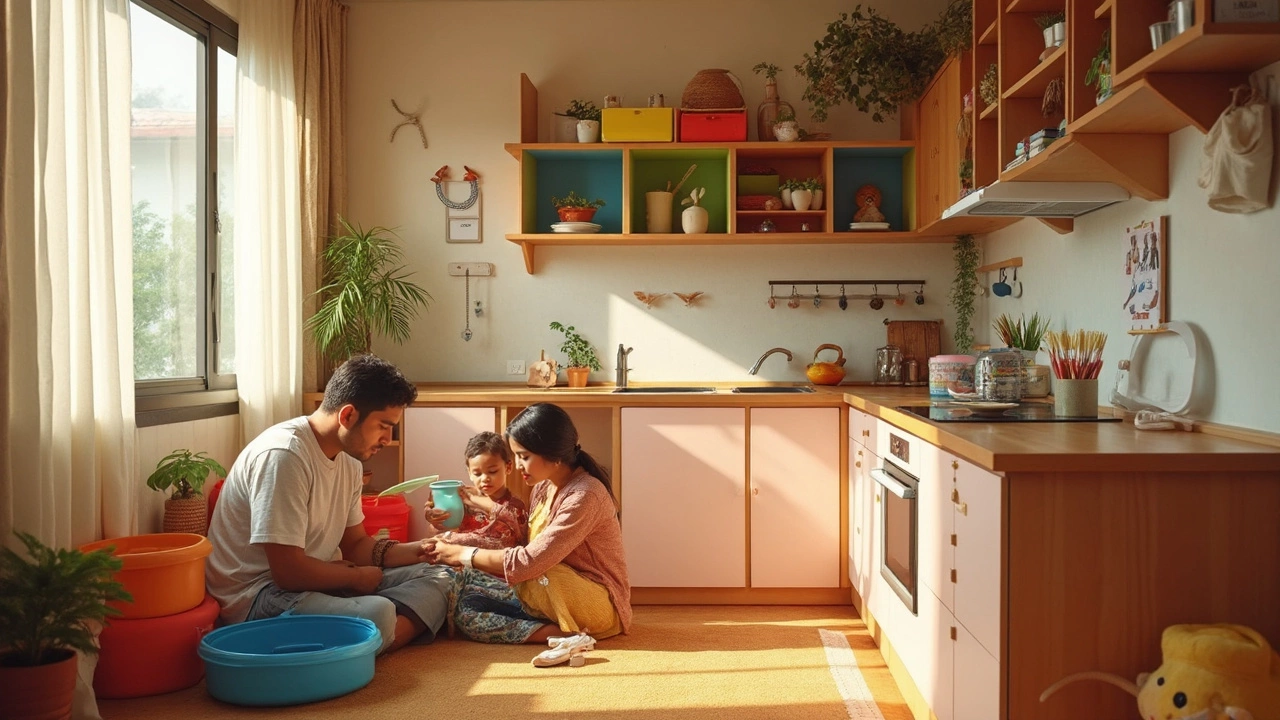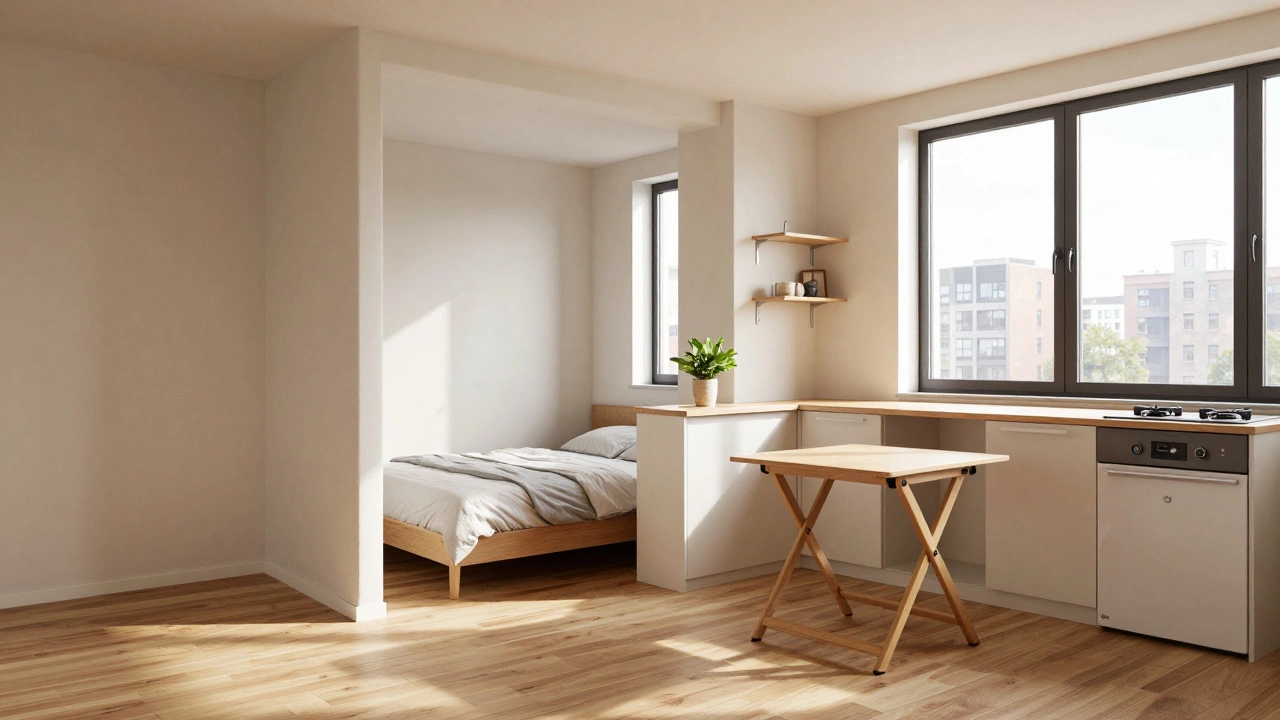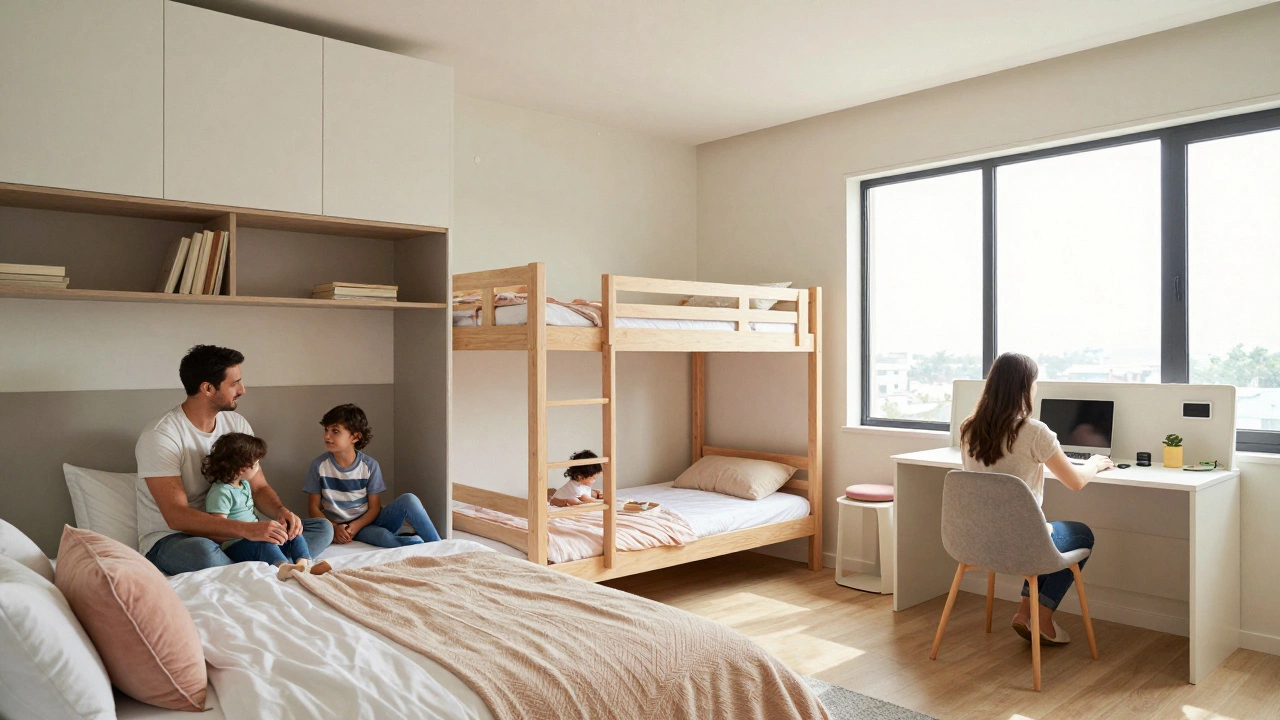500 square feet. Sounds tiny, right? To put it in perspective, that’s about the size of two parking spots or a single badminton court. Yet, some folks turn this small space into a full-blown 2BHK apartment—with two bedrooms, a hall, and a kitchen all squeezed in.
People usually think it’s impossible to fit a family into such a small home. But honestly, you’d be surprised at what can actually work if you lay things out smartly and don’t keep more than you need. Efficient storage, multi-purpose furniture, and creative use of corners can do wonders.
So, what’s it like living in 500 sq ft? Compact living isn’t just about squeezing in—it’s about making choices. You’ll probably need to give up bulky cupboards and switch to things like wall shelves, under-bed drawers, or folding tables. The upside? Cleaning takes half the time, and there’s no room to collect piles of junk you never use anyway.
- What 500 sq ft Actually Looks Like
- Who Can Make a 500 sq ft 2BHK Work
- Space-Saving Hacks That Actually Help
- Managing Everyday Life and Storage
- Dealing with the Challenges
- Should You Try Compact Living?
What 500 sq ft Actually Looks Like
Picture this: 500 sq ft means every square inch matters. If you draw a rectangle that’s about 20 feet by 25 feet, you get 500 sq ft. That’s your entire living space, including two bedrooms, one hall, and a kitchen. Some apartments chunk it differently—maybe you get 18 x 28 feet or even a square 22 x 22 feet. The point is, you’ll have to make do with a compact layout that puts every area super close.
You’re probably wondering if there’s actual room for beds, a sofa, maybe a dining table, and storage. Here’s a rough breakdown of how builders usually split things up in a 2BHK packed into 500 sq ft:
| Room | Average Size (sq ft) |
|---|---|
| Bedroom 1 | 80 - 100 |
| Bedroom 2 | 60 - 80 |
| Living Room (Hall) | 100 - 120 |
| Kitchen | 45 - 60 |
| Bathrooms (1-2) | 30 - 50 each |
If you total that up, you’ll notice there’s just enough space to walk around, open cabinets, and sleep comfortably. No wasted corners or wide corridors.
It’s important to manage your expectations. Walls are thinner, rooms feel cozy, and there’s usually little extra space for huge cupboards or double beds in all rooms. Apartments this size often have combined living and dining areas or kitchens that open into the hall to save space.
- A standard queen bed (5 x 6.5 feet) takes up almost a tenth of your total home space.
- Most folks place the second bedroom near the main door and use it as a kid’s room or a small office.
- You might have to get creative with modular furniture to pull this off without clutter.
So, if you’re thinking a 500 sq ft house is just a matchbox, it’s actually more like a Swiss Army knife—compact but surprisingly functional if you plan things right.
Who Can Make a 500 sq ft 2BHK Work
Not everyone can thrive in a 500 sq ft house, but some people actually find it totally manageable. If your daily life is simple and you don’t need tons of stuff or privacy, a small 2BHK can be surprisingly liveable.
Here are a few types of people who tend to do well in these compact homes:
- Young couples: Many newlyweds or couples without children are going for smaller apartments to stay close to city centers or work hubs. Less space means less cleaning and lower costs for rent and utilities.
- Single parents with a small child: One parent and a kid can get by with just two bedrooms, so long as they keep clutter under control.
- Flatmates: Friends or colleagues sharing rent are often willing to trade space for a more affordable address and don’t mind close quarters.
- Retired folks: Older people who want to downsize from a big family home love these manageable, low-maintenance spaces.
- Minimalists: If you follow the ‘own less, live more’ mantra, life in a 500 sq ft 2BHK feels natural, not cramped.
To give a sense of how people are making this work, check out this short table based on a 2024 survey from a well-known real estate site on who’s most likely to rent a small 2BHK in Indian metros:
| Who | Percentage of 500 sq ft 2BHK renters |
|---|---|
| Young couples | 35% |
| Single parents & kids | 16% |
| Flatmates | 24% |
| Retirees | 12% |
| Others | 13% |
People who work from home with lots of equipment, big families, or those who love to host big gatherings usually struggle with these spaces. If you value your personal space and hate clutter, it’s all about making conscious, smart choices about what actually deserves a spot in your home.
Space-Saving Hacks That Actually Help
If you’re struggling to fit everything into a 500 sq ft house, you need smart hacks that aren’t just pretty in Instagram photos—they’ve got to work in real life. Here’s what actually makes a difference when you’re trying to live big in a small 2BHK apartment.
The first move? Ditch bulky furniture. Think beds with built-in storage drawers, foldable dining tables, and sofas that have hidden compartments underneath. It’s not about cramming, but using every bit of space that usually goes ignored.
- Wall-mounted shelves: Instead of tall bookcases or chunky cupboards taking up floor space, use wall shelves. Fill vertical space for books, kitchen essentials, or even foldable desks.
- Multipurpose furniture: Opt for ottomans that double as storage or a fold-out desk you can hide away when you’re done working. Some dining tables expand only when you need extra seats.
- Sliding doors: Regular doors take up swinging space you just don’t have. Switch to sliding or pocket doors, especially for bathrooms or the kitchen.
- Hooks and racks everywhere: Install hooks on the backs of doors and inside cupboards. Hang bags, pans, keys, or even foldable chairs.
- Under-bed storage: Seriously underrated. Suitcases, winter blankets, or sports equipment can all disappear under your bed and free up your wardrobe for daily stuff.
An interesting fact: In Tokyo, where small apartments are normal, people often use stackable appliances and foldable partitions to re-shape their rooms throughout the day. It’s not about living with less but making every item earn its spot.
If you want a 2BHK apartment that feels roomy in just 500 sq ft, start by getting rid of what you don’t use and investing in things that work twice as hard. Less clutter means there’s actually space to breathe, even if your kitchen shares a wall with your bed.

Managing Everyday Life and Storage
Trying to fit daily life into a 500 sq ft house means storage has to be smart, not just stacked. On average, a person in urban India owns about 350 items—everything from clothes and utensils to gadgets. Cramming it all into a small space? That’s tough, unless you plan well.
First things first, every piece of furniture should double up as storage. Think of beds with drawers underneath or sofas with space inside to stash blankets. Wall shelves and hanging racks make use of vertical space, so you free up valuable floor area.
- Use kitchen cabinets that stretch up to the ceiling and mount magnetic strips for knives and spice jars.
- Get a compact dining table that folds away, freeing up more walking room.
- Store seasonal items or rarely used stuff in suitcases under the bed.
- Shoes can go in over-door racks or organizers that fit behind room doors.
- Mount hooks and baskets on bathroom walls for toiletries and cleaning supplies.
Decluttering has to be a regular habit. People who live happily in 500 sq ft often organize a tiny clean-up every two weeks, so things don’t pile up. The famous 80/20 rule (Pareto Principle) works great here—you use only about 20% of your things 80% of the time, so keep those handy and consider letting the rest go.
| Storage Strategy | Potential Space Saved |
|---|---|
| Under-bed storage | Up to 15 sq ft |
| Wall shelves & cabinets | 10-20% more floor space |
| Foldable furniture | 4-8 sq ft per item |
Small apartments force you to prioritize. You need to know what you actually use every day and what you’re just keeping for “someday.” It’s not about living with less just for the sake of it. It’s about making sure every bit of space—and every item—has a job. That’s what turns a 500 sq ft house from cramped to comfortable.
Dealing with the Challenges
Living in a 500 sq ft house sounds appealing for its simplicity, but it’s not always smooth sailing. The first thing you notice? There’s nowhere to hide your mess. Every bag, shoe, or dinner plate quickly turns into clutter if you don’t stay on top of things.
Privacy is kind of a big deal in such a small space. If you’re sharing the flat with a partner, roommate, or a small family, you’ll bump into each other a lot—sometimes literally. Even with two bedrooms, both are usually just big enough for a bed and a few essentials. That makes quiet time hard to pull off.
Then there’s the issue of storage. Standard cupboards or double-door fridges hog too much space. You have to pick stuff that fits the space, not just your taste. Suddenly, organizing every drawer and shelf becomes a mission.
Here’s a look at some of the top pain points and clever workarounds:
- Noise travels fast: Thin walls mean whatever happens in the hall, everyone in the house hears it. Try soft-close doors, thick curtains, and rugs to muffle sound.
- Entertaining guests? The couch folds. Chairs stack. Floor seating with cushions works in a pinch.
- No room for bulky appliances: Opt for a mini washing machine, a small stove, or a fold-out ironing board.
According to a 2024 micro-housing survey, 78% of small apartment dwellers said they had to cut down on possessions by at least half. Here’s how the most common 500 sq ft challenges stack up:
| Challenge | How People Handle It |
|---|---|
| Limited Storage | Under-bed boxes, wall-mounted shelves, vacuum storage bags |
| Lack of Privacy | Portable room dividers, smart curtain placement |
| Entertaining Guests | Extendable tables, lightweight foldable chairs |
| Noisy Spaces | Textiles for sound dampening, white noise apps |
| Keeping Tidy | Daily declutter rituals, strict "one in, one out" rule |
It takes real effort to keep things running smoothly in a compact home. The smaller the space, the more each decision matters—what to buy, what to keep, and where it goes. But once you learn to work with the limits, things start to feel less like a challenge and more like just how life works in a small place.
Should You Try Compact Living?
If you’re on the fence about squeezing your life into a 500 sq ft house, it helps to get real about what this choice actually means day after day. Tiny homes and compact 2BHKs aren’t some Instagram fantasy—they’re a practical option for people who don’t need tons of possessions or a lot of private space.
Let’s break down who really benefits from this set-up. Students, young couples, or small families without hoards of stuff tend to settle in just fine. If you’re out most of the day or travel often, you’re less likely to crave extra space. But if you host big gatherings or crave quiet corners away from everyone, it could start to feel cramped fast.
Money-wise, compact living usually means lower rent, smaller energy bills, and less cash wasted on things you don’t need. A study from Mumbai in 2023 showed average monthly savings of up to 30% on utility bills for residents of homes under 600 sq ft compared to bigger flats. Cleaning is also faster—expect to spend about 15-20 minutes sweeping up the place instead of an hour every weekend.
| Aspect | Typical 500 sq ft Apartment | Standard 2BHK (950 sq ft) |
|---|---|---|
| Average Rent (Tier-1 city) | ₹18,000/month | ₹32,000/month |
| Monthly Utility Bills | ₹1,600 | ₹2,400 |
| Cleaning Time (per week) | 1.5 hours | 4 hours |
If you think of yourself as someone who “can’t live without” a big kitchen or lots of wardrobe space, be honest before making the leap. Downsizing means getting creative—maybe using a fold-down dining table, or hanging shelves above the door to store bags and shoes. You’ll have to communicate more with anyone sharing the apartment, since privacy is limited and every item really needs to earn its keep.
It’s not for everyone, but if you like the idea of a lighter lifestyle and easier upkeep, a 500 sq ft 2BHK could be the sweet spot between affordability and comfort. Just make sure you try living light for a few weeks—clear out your current clutter and see how it feels—before signing up for the real thing. Compact living only works if your day-to-day habits match the space, not just your budget.





